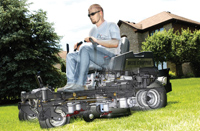Magic Circle Practices Cost-Conscious Product Development
 At Magic Circle Corp., which makes mid-mount, zero turning lawn mowers, reliability is one of its driving values. The company has followed the success of its flagship product, the Dixie Chopper, with a number of other product lines and models throughout its near 30-year history. Some of the new products started out as "wish lists" compiled from the company's dealers, who now number more than 500. This was the case for the company's newest product line, the Iron Eagle, a lower-cost machine that makes the capabilities of the $8,000 Dixie Chopper affordable to homeowners. The dealers outlined what they wanted in a lower-priced model, and the Magic Circle design team got to work.
At Magic Circle Corp., which makes mid-mount, zero turning lawn mowers, reliability is one of its driving values. The company has followed the success of its flagship product, the Dixie Chopper, with a number of other product lines and models throughout its near 30-year history. Some of the new products started out as "wish lists" compiled from the company's dealers, who now number more than 500. This was the case for the company's newest product line, the Iron Eagle, a lower-cost machine that makes the capabilities of the $8,000 Dixie Chopper affordable to homeowners. The dealers outlined what they wanted in a lower-priced model, and the Magic Circle design team got to work.A Revised Approach
The Iron Eagle's lower price tag, at $5,000, meant there would be a lower profit margin as well, and that factor had to be accounted for in the new mower's development.
"We wanted to develop it as inexpensively as possible, which meant that we couldn't use our normal trial-and-error process," says Dwon Williams, the CAD/CAM manager and machine shop supervisor at Magic Circle. "In that process, we formed a frame then got pieces from vendors, put everything together and checked the fit. Every stage of the process was based on physical parts and physical testing, and it usually took about one year to get a new mower from concept to production. With the Iron Eagle, we didn't have the luxury of all that time or resources."
For the Iron Eagle, Williams and his colleagues decided to forego the metal cutting and physical assembly in favor of an all-virtual product development process based on the Solid Edge design software from Siemens PLM Software.
Engineers put digital mower components together in an assembly model. Some components, including the distinctively shaped molded plastic gas tank, were modeled in-house. Other components were brought in as CAD models from suppliers. The assembly model created has approximately 1,000 components and assemblies, and represents the complete Iron Eagle mower.
Way Ahead of Schedule
Working virtually turned out to be significantly faster and less expensive than the old trial-and-error process. "Instead of one year, we went from the wish list to a production model of the Iron Eagle in only three months," says Williams.
The nine-month time savings represented a big economic benefit for Magic Circle. The development of a new mower typically involves up to 20 people. Eliminating that many man-months of labor represents a significant cost savings for the company.
Even though the design process went quickly, the company was not able to have a working model ready for a big trade show in Louisville, so instead they took rendered images of the Solid Edge assembly model. "We got 800 orders just based on the renderings," says Williams.
He is also looking forward to implementing Solid Edge with Synchronous Technology, which will allow Magic Circle to import and modify suppliers' CAD models in any format, sparing conversion work.
The virtual development process used for the Iron Eagle is now Magic Circle's normal practice. "We're all being asked to do more with less," he says. "We can't afford to waste material. Solid Edge allows you to develop new products while putting fewer resources into play, and this is ideal for riding out a recession."
